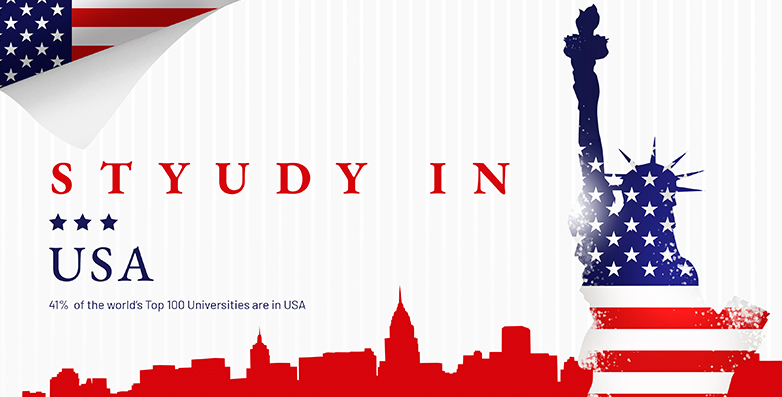The United States has long been a beacon for students worldwide, offering unparalleled academic opportunities, cultural diversity, and pathways to global careers. With over 950,000 international students enrolled in 2022, the U.S. remains the top destination for higher education. Whether you’re drawn to cutting-edge research, flexible academic programs, or vibrant campus life, studying in the USA opens doors to transformative experiences. This guide explores why the U.S. stands out, how to navigate the application process, and what to expect from life as an international student.

Why Choose the USA for Higher Education?
1. World-Class Academic Excellence
The U.S. is home to 15 of the top 20 universities globally (QS World Rankings 2023), including institutions like the California Institute of Technology (Caltech), University of Chicago, and Duke University. These universities prioritize innovation, critical thinking, and hands-on learning. For instance, MIT’s Media Lab and Stanford’s Silicon Valley connections provide students with opportunities to engage in groundbreaking projects and startups.
American degrees are globally recognized, giving graduates a competitive edge in industries ranging from tech to finance. The emphasis on interdisciplinary learning allows students to combine majors like Computer Science and Music or Engineering and Business, fostering versatile skill sets.
2. Diverse Range of Academic Programs
Unlike many countries with rigid curricula, U.S. universities offer unmatched flexibility. Students can explore courses across disciplines before declaring a major, often customizing degrees through minors or specializations. Unique programs like Cornell University’s Viticulture program (wine studies) or the University of Colorado’s Aerospace Engineering highlight the diversity of options.
Community colleges like Santa Monica College also provide affordable pathways to transfer into top universities, ideal for students seeking cost-effective entry points.
3. Cultural Diversity and Campus Life
U.S. campuses are microcosms of global culture. At institutions like New York University or UCLA, you’ll interact with peers from over 100 countries. Universities host cultural festivals, international food fairs, and clubs like the Indian Student Association or African Diaspora Collective, ensuring students feel at home.
Beyond academics, campuses offer state-of-the-art facilities—think Olympic-sized pools, AI research labs, and student-run startups. The University of Michigan, for example, boasts 1,500+ student organizations, from Quidditch teams to climate activism groups.
4. Career Opportunities and Post-Study Work
The U.S. economy’s sheer scale provides internships and jobs across sectors. Programs like Curricular Practical Training (CPT) and Optional Practical Training (OPT) allow students to work during and after studies. STEM graduates can extend OPT to three years, a significant draw for tech aspirants.
Companies like Google, Tesla, and Goldman Sachs actively recruit from U.S. universities. Additionally, alumni networks at schools like Harvard and UC Berkeley offer mentorship and job placement support.

Navigating the U.S. University Application Process
1. Choosing the Right University
Consider factors like:
- Program Reputation: Research faculty expertise and industry ties. Carnegie Mellon excels in AI, while Parsons School of Design leads in fashion.
- Location: Urban campuses (e.g., NYU) offer networking opportunities, while rural ones (e.g., Dartmouth) provide focused environments.
- Cost and Financial Aid: Public universities like the University of Texas at Austin have lower tuition for state residents, while private schools like Princeton offer generous scholarships.
2. Application Requirements
- Standardized Tests: While many schools have adopted test-optional policies post-COVID, strong SAT/ACT or GRE scores strengthen applications. English proficiency tests (TOEFL/IELTS) are mandatory.
- Essays and Letters of Recommendation: Personal statements should highlight unique experiences, like volunteering or entrepreneurial ventures.
- Portfolios/Interviews: Required for arts or tech programs (e.g., Rhode Island School of Design).
3. Visa Process
After acceptance, secure an I-20 form and apply for an F-1 student visa. Prepare for embassy interviews by demonstrating financial stability and academic intent.
Student Life in the USA: What to Expect
1. Accommodation and Living Costs
Most freshmen live on-campus in dormitories, fostering community. Off-campus housing is cheaper in cities like Austin compared to San Francisco. Budget 10,000–10,000–15,000 annually for living expenses.
2. Health and Safety
Universities require health insurance, often provided through plans like Aetna. Campus police and safety apps like LiveSafe ensure student security.
3. Cultural Adaptation
Initial culture shock is common. Participate in orientation programs and cultural clubs to build connections. Universities like Purdue host workshops on American classroom etiquette, like active participation and debates.
Challenges and Solutions for International Students
1. High Tuition Costs
Public universities charge 20,000–20,000–40,000 annually, while private ones exceed $50,000. Seek scholarships (e.g., Fulbright, Hubert Humphrey) or assistantships.
2. Visa and Immigration Policies
Stay updated on OPT/STEM extensions and H-1B visa changes. Consult university international offices for legal guidance.
3. Academic Pressure
U.S. universities emphasize continuous assessment through quizzes, essays, and group projects. Use academic resources like writing centers or peer tutoring.

Tips for Success as an International Student
- Network Early: Attend career fairs and LinkedIn events.
- Leverage University Resources: Use mental health counseling and resume workshops.
- Explore the Country: Travel during breaks—hike the Grand Canyon or explore New Orleans’ jazz scene.
Conclusion
Studying in the USA is an investment in your future, offering academic rigor, cultural enrichment, and career growth. By researching programs, preparing thoroughly, and embracing new experiences, you’ll maximize your journey. As you embark on this adventure, remember: the skills and connections you gain will shape your global trajectory.